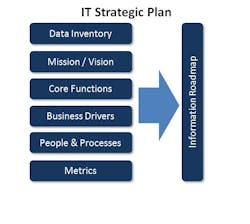In today’s business environment, we all have the need for accurate and timely information about our organizations. This information may be on the organization’s finances, operations, maintenance, human resources and so on. It may be high level organization-wide or detailed information. When we ask for this information from our staff though, we often are told that they don’t have the information or the data is not in the proper format to make it useful and easy to understand. And when we do get the information, we often find that we can’t make sense of the data or that it is inconsistent because it is queried from multiple data sets which are used for different purposes.
How did we get here?
First, let’s recognize that there are essentially three types of data sources. Repositories include sophisticated enterprise-wide databases, business unit databases, and spreadsheets and hard copy reports or ledgers.
- Enterprise-wide databases: These are usually big systems used to track and manage the organization’s business operations. Enterprise-wide systems are typically used by multiple business units and integrate different functions. An example of this is an enterprise resource planning (ERP) system used to track and manage the organization’s finances. ERP systems generally have the capability to integrate the general ledger, accounts payable and receivable, billing and invoicing, budget, purchasing and warehouse/inventory functions into one system. The airport operational database (AOBD) is an example of an operations enterprise-wide system which incorporates airline schedules, resource management for gates, aircraft parking positions, ticket counters, baggage claim systems and feeds the flight information display system (FIDS).
Most likely, your organization is using some of these systems modules but not all of them. Furthermore, some of the modules may be used with a higher degree of accuracy than others. In theory, enterprise-wide systems can provide opportunities for organizations to manage their operations more efficiently and provide better access to better information but the reality is that these systems are expensive to implement properly and require staff resources to maintain the data so that it is current and complete.
- Business unit databases: Individual business units likely have their own data systems to track information that they need to carry out their responsibilities. These may be sophisticated systems such as a parking management system or a computerized maintenance management system (CMMS) also referred to as an asset management system (AMS), systems with a very specific function such as tracking customer feedback or utility usage, or systems developed in-house to track and maintain information on lease agreements or ground transportation information for passengers. Other off-the-shelf systems include noise monitoring, security badging and access control to name a few. These systems may be hosted remotely, on your airport’s network or on a single desktop computer.
- Individual databases: Within the business unit, many staff will likely have relatively simple databases to track all sorts of information that is required for them to be effective in their jobs. These may include training logs, the status of projects assigned to them or other staff, equipment and supply inventories, and simple contact lists. Most of this data is likely stored in spreadsheets or even hardcopy logs and lists.
Each of these types of data sources supports an important function within the organization whether or not it is integrated in an enterprise system or a staff’s individual database. And while these data sets may contain similar data, the information is used for different purposes and, as a result, the data will likely be collected and represented differently for the unique purpose. The bottom line is users need access to data that supports their functions but may not necessarily support other potential users’ functions. Consequently, similar data may conflict and contradict each other making it very frustrating for managers.
Secondly, it is helpful to understand the business drivers behind the need for the information. Is the information required for a recurring report such as monthly passenger and aircraft operations reports or financial reports or is it a one-time request for a special project? Also, to whom is the information going to be shared? If it is the public or for people outside the organization then context and simplicity are likely to be extremely important whereas information used to respond to in-house requests can be more detailed and informal.
Thirdly, the context in why the data is collected should be considered. If the data is to be used for trend analysis, then consistency between reporting periods is a must. On the other hand, if the data is going to be used for benchmarking purposes, then adherence to industry definitions and standards are important.
Having an understanding of how the data is used and how it is collected will help managers sort through sometimes incomplete and inconsistent data. Different business units within an organization may use similar data but they may use it differently to suit their own needs. It is natural that there will be inconsistencies in the data such as the reporting period (i.e. hourly, daily, weekly, etc.). It is to be expected that there will also be inconsistencies in the definitions of the data elements. For example, total passengers may represent the total of all enplaning and deplaning revenue passengers to the billing unit but represent revenue passengers plus non-revenue passengers for another unit.
Solutions
In the short-term, a good starting point is to understand what data your organization collects and maintains by conducting a data inventory. This should include a description of the data set, how it is collected and reported, the key data elements, the database system (vendor, software used, size, date of implementation, etc.), who uses the data and for what purpose. This inventory should be updated on a regular basis to ensure it is current and useful. A benefit of sharing the information inventory with the entire organization is that staff will see that others may be maintaining databases that were previously unknown to them but could be of use. Additionally, informal discussions between staff will likely start taking place to integrate and standardize the data.
A long-term solution is to develop an IT strategic plan for the organization. This is slightly different than an IT master plan which will generally focus on the organization’s IT infrastructure needs such as network design and configuration, hardware, software and communication protocols. Instead, the IT strategic plan addresses the organization’s business information needs and includes a roadmap for implementing solutions to meet those needs. Done well, the IT strategic plan should take anywhere from three months to a year to develop and should cover the next three to five years with the most focus on the next 12 to 18 months. IT infrastructure can be included as part of the strategic plan but these should also be driven by business process needs.
Core to the IT strategic plan is the organization’s mission and vision statements as these drive the overall priorities for the organization. The core functions of each business unit should be documented so everyone in the organization clearly understands what the responsibilities are for their own units as well as other units. Identify and map the primary business processes of each business unit with attention to both business processes that are conducted entirely within a business unit as well as those processes that involve multiple business units. Documenting business processes is usually best accomplished by using outside consultants who are non-preferential towards the individual business units and have a thorough understanding of how airports work.
Lastly, the IT strategic plan should be transparent by allowing staff access to all of the business processes within the entire organization (exclusive of sensitive information). This results in a better understanding of each of the players’ roles and responsibilities and how they may affect other business units either upstream or downstream.
Factors for a Successful IT Strategic Plan
The development and implementation of a successful IT strategic plan requires support and continuous engagement from senior management. Often, it is best to have a senior division manager such as the chief information officer (CIO) or chief financial officer (CFO) serve as the visible champion of the project supported by a mid-level project manager.
The project should have clearly articulated goals and objectives including deliverables and schedules. These should be shared with the stakeholders. Additionally, metrics are critical to measuring the progress and ultimate success of the development and implementation of the plan.
Perhaps the most important success factor is engaging all business process stakeholders at every level of the organization. Different staff functions at different levels of the organization will have different information needs. They may also be responsible for maintaining some of the data elements. Engaging stakeholders, who may also be external to the organization, is critical to ensure “buy-in”. Successful projects are not implemented by a decree issued by management but instead are embraced and supported at all levels of the organization.
As with most successful projects, stakeholders should be treated as valued team members. In addition to valuing stakeholder input, this means that everyone is accountable to each other. Sometimes deadlines may need to be met when it is inconvenient or the value of the task-at-hand may not be readily apparent. Other times difficult issues may need to be addressed and decisions made in cases where not everyone will be pleased. Many of these difficult decisions need to be made by senior management and they should be prepared to make these difficult decisions. Stakeholder accountability is often overlooked.
Having an up-to-date inventory of your organization’s data and information and understanding the context of those data resources allow you to ask the right questions and use the information more effectively. Airport managers are fortunate that there are very good resources to help navigate and understand their airport data repositories. Airports Council International (ACI) offers its 2015 ACI Key Performance Indicators report as well as itsannual Airport Economics Report. The Airport Cooperative Research Program (ACRP) also has a number of useful studies to assist airports in developing IT strategic plans, performance measurement systems and peer airport benchmarking programs.
As the Principal of Yankee & Associates, LLC, Tod Yankee has over 30 years of aviation experience, working for both airlines and airports and as an airport management consultant. He works with airports on their business information needs and assists them in developing information strategies.



